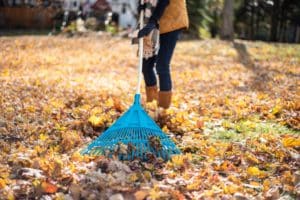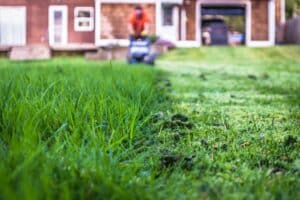Winter has arrived in central Iowa and the lawns have gone dormant for the year. Dormancy is a very important task for your lawn to complete. If the lawn didn’t go dormant, the grass would die, and you would be stuck having to re-seed the lawn every year.
What is dormancy? Dormancy is the process where the living grass completes photosynthesis and makes nutrients that are stored in the root system. Environmental factors such as shorter day length and colder temperatures cause internal signals in the grass to start breaking down its leaves which would be damaged by freezing temperatures in the winter. During dormancy, the grass uses very little energy. In the springtime, when the environmental conditions change, the energy stored is used to regrow the leaves and the grass turns green again.

Since dormancy is so important for grass, what can a homeowner do to make sure the grass is ready for winter? One of the most important tasks is keeping the leaves off the lawn. Many people ask us if mulching the leaves is okay or if the leaves should be removed from the lawn. We recommend removing the leaves from the lawn and having them composted. It can take some time for the leaves to fully break down and if that leaf sits on the lawn too long, it can cause the grass underneath to become shaded and stunted. Without adequate sunlight, the grass is forced to use nutrients from the root system to maintain life. Those nutrients in the root system are essential for the grass to live through dormancy. If removing the leaves from the lawn is not an option, then we would recommend mulching them.
Whether from compost or from fertilizer, also maintaining a correct nutrient balance for your lawn in important. Without nitrogen and potassium, the lawn would not have enough nutrients to grow during the summer or be able to store nutrients for dormancy. The lawn programs we offer encourage a minimum of at least four fertilizer applications during the growing season. We complete fertilizer applications in early spring, early summer, late summer, and mid-fall. Our fertilizer is applied in slow-release pellets which slowly release the nutrients during a period of 30-45 days. If you can use compost from your leaves or from a purchased source, we would recommend applying the compost in late August or early September. This will aid in establishing new seed and will give the grass a boost of nutrients going into the fall as the grass prepares for dormancy.
Using proper rates of fertilizer is important. Too much fertilizer can change the pH of the soil. If the soil is too acidic or too basic, the grass can be severely stunted or killed. An optimal pH of 5.8-7 is ideal for Iowa lawns. Generally, applications of lime are not needed in Iowa since our soil is generally already basic. However, if too much fertilizer has been applied over a period, an application of lime can be completed to correct the soil pH. Only a soil test completed by a professional lab can tell you an accurate pH level of your soil. Other substances that can change the pH of the soil include de-icing chemicals used in the winter on driveways and sidewalks. Salt can change the structure of the soil and if the soil is too salty, it can kill the grass and any plants growing along the edges of the treated concrete. If salt damage is seen on your lawn during the spring, an application of gypsum can be used to help flush the salt from the soil.

Lawn height is also a very important factor in a healthy lawn and a lawn that will survive dormancy well. The taller the blades of grass are, the more shading of the soil from sunlight will be allowed. This will help to maintain moisture levels in the soil. Longer blades of grass also allow for more surface area for photosynthesis to cover. More photosynthesis means more nutrients for the grass and when combined with higher soil moisture, the grass can develop a deeper root system. We recommend maintaining a minimum lawn height of at least three inches. When mowing the lawn, taking off more than one third of the total grass height is also not recommended. If more than one third is being taken off, more frequent mowing of the lawn might be required. Bagging of the grass clippings is generally not required. We always recommend mulching the grass clippings whenever possible. If the grass clippings are clumping on the lawn, those clumps can be removed or raked out evenly over the entire lawn. The grass clippings contain many nutrients which will degrade rapidly back into the soil.
Over time of repeated mulching, grass clippings can accumulate on top of the soil in a layer called thatch. Just as a thatch roof on a home, thatch on top of the soil can create a boundary in which water runs off the soil rather than being able to absorb into the soil. Some companies offer dethatching which is a process we do not recommend. De-thatching does more harm to the grass than it does good. Dethatching is a series of quickly spinning tines which rake the dead grass out of the lawn. However, it also takes the living grass out of the lawn and disrupts the rhizome system which grass uses to transport nutrients. There are two much better alternatives than dethatching a lawn. One option is aeration. Besides fertilizing and weed control, aeration is the single most important task that can be done to a lawn. Aeration pokes holes in the lawn and removes plugs or cores of soil from the lawn. This allows water to get deep in the soil and allows the grass to develop deep root system. A good plug should be at least 3 inches deep, and the plugs can be left on top of the soil and mulched with the next mowing.
A second alternative to dethatching is slit seeding. Slit seeding should be done in lawns that have a thin stand of grass or every three years. Slit seeding uses a machine with a series of knives that cut through the thatch and into the top one quarter inch of soil. After the knives cut the slits, a tube drops grass seed from a hopper on the machine into the slits. This allows the grass seed to contact the soil which is needed for the grass seed to grow. While slit seeding does also do some damage to the grass rhizomes, the knives do not cause as much damage and since it’s being combined with grass seed, the new grass seed will help to fill in any damage caused to the grass. Late August and early September are the optimal times to plant grass seed in central Iowa.
If you are interested in a lawn consultation or if you would like more information on a specific topic, please send us a message here.



